- With standard equipment
- With safety pack
Find more information in the General Comments section of the assessment
Find more information in the Rating Validity tab of the assessment
- See More
- See More
- See More
- See More
- Good
- Adequate
- Marginal
- Weak
- Poor
 Passenger
Passenger
 Driver
Driver
 Rear Passenger
Rear Passenger
 Driver
Driver
 Car
Car
 Pole
Pole
 Rear Seat
Rear Seat
 Front Seat
Front Seat
- Good
- Adequate
- Marginal
- Weak
- Poor


Passenger
outboard
center
Fitted to the vehicle as standard
Not fitted to the test vehicle but available as option
Not Available
-
i-Size CRS
-
ISOFIX CRS
-
Universal Belted CRS
Easy
Difficult
Safety critical
Not allowed
| Seat Position | ||||
|---|---|---|---|---|
| Front | 2nd row | |||
| Passenger | Left | center | Right | |
| Maxi Cosi 2way Pearl & 2wayFix (rearward) (iSize) | ||||
| Maxi Cosi 2way Pearl & 2wayFix (forward) (iSize) | ||||
| BeSafe iZi Kid X2 i-Size (iSize) | ||||
| Maxi Cosi Cabriofix & FamilyFix (ISOFIX) | ||||
| BeSafe iZi Kid X4 ISOfix (ISOFIX) | ||||
| Britax Römer Duo Plus (ISOFIX) | ||||
| Britax Römer KidFix XP (ISOFIX) | ||||
| Maxi Cosi Cabriofix (Belt) | ||||
| Maxi Cosi Cabriofix & EasyBase2 (Belt) | ||||
| Britax Römer King II LS (Belt) | ||||
| Britax Römer KidFix XP (Belt) | ||||
Easy
Difficult
Safety critical
Not allowed
In the frontal offset test, protection of both the 6 year and 10 year dummies was good or adequate. In the side barrier test, protection was good for all critical parts of the body. The front passenger airbag can be disabled to allow a rearward-facing child restraint to be used in that seating position. Clear information is provided to the driver regarding the status of the airbag and the system was rewarded. All of the restraint types for which the XC60 is designed could be properly installed and accommodated.
- Good
- Adequate
- Marginal
- Weak
- Poor

Head Impact 17.3 Pts
Pelvis Impact 2.6 Pts
Leg Impact 6.0 Pts
| System Name | City Safety | ||
| Type | Auto-Brake with Forward Collision Warning | ||
| Operational From | 4 km/h | ||
| Additional Information | Defaults on for every journey; operates above 40km/h and in low ambient light | ||
| PERFORMANCE | | |||
| Autobrake Function | |||
| Avoidance | Mitigation | ||
|
Running Adult crossing from Farside
|
Collision avoided up to 60 km/h | ||
|
Walking Adult crossing from Nearside -25%
|
Collision avoided up to 60 km/h | ||
|
Walking Adult crossing from Nearside -75%
|
Collision avoided up to 60 km/h | ||
|
Running Child from behind parked vehicles
|
Collision avoided up to 40 km/h | Impact mitigated up to 60 km/h | |
The bonnet provided predominantly good or adequate protection to the head of a struck pedestrian with some poor results recorded only at the base of the windscreen and on the stiff windscreen pillars. The bumper scored maximum points for its protection of pedestrians' legs, with good results at all test points. Protection of the pelvis was mixed. The autonomous emergency braking system scored maximum points in tests of its pedestrian detection, with good results in all test scenarios and at all speeds.
- Good
- Adequate
- Marginal
- Weak
- Poor
| System Name | Road Sign Information & Speed Limiter |
| Speed Limit Information Function | Camera based, subsigns supported |
| Warning Function | Active braking (no warning necessary) |
| Speed Limitation Function | System advised (accurate to 5km/h) |
| Applies To | All seats | ||
| Warning | Driver Seat | Front Passenger(s) | Rear Passenger(s) |
| Visual | |||
| Audible | |||
|
|||
| System Name | Lane Departure Warning with Lane Keeping Aid |
| Type | Lane Keep Assist and Lane Departure Warning |
| Operational From | 65 km/h |
| Warning | Audible |
| Performance | |
|
LKA Confirmation Test
|
Pass (5/5) |
|
LDW Confirmation Test
|
Pass |
| System Name | City Safety | |||
| Type | Forward Collision Warning with Auto-Brake | |||
| Operational From | 4 km/h | |||
| Additional Information | Default On; Supplementary Warning; Seatbelt Activation | |||
| Performance | | ||||
| Autobrake Function Only | Driver reacts to warning | |||
| Operational Speed | 4-250 km/h | 4-250 km/h | ||
| Approaching a stationary car | See AEB City | Crash avoided up to 80km/h. | ||
| Approaching a slower moving car | Crash avoided up to 70km/h. | Crash avoided up to 80km/h. | ||
| Following a car at short distance | ||||
| Car in front brakes gently | Avoidance | Avoidance | ||
| Car in front brakes harshly | Avoidance | Avoidance | ||
| Following a car at long distance | ||||
| Car in front brakes gently | Avoidance | Avoidance | ||
| Car in front brakes harshly | Avoidance | Avoidance | ||
A seatbelt reminder is standard equipment for the front and rear seats. The speed assistance system uses a camera to recognise the local speed limits and to inform the driver, who can then choose to set the limiter appropriately. Lane Departure Warning with Lane Keeping Aid is also standard and alerts the driver when the car is drifting out of lane and helps to steer away from the lane edge. The autonomous emergency braking system scored maximum points when tested at highway speeds, with collisions avoided at all test speeds and in all scenarios.
- Specifications
- Safety Equipment
- Videos
- Rating Validity
Specifications
Tested Model Volvo XC60 D4 AWD Momentum, LHD
Body Type - 5 door SUV
Year Of Publication 2017
Kerb Weight 1873kg
VIN From Which Rating Applies - all XC60'S
Class Large SUV
Safety Equipment
Note: Other equipment may be available on the vehicle but was not considered in the test year.
Fitted to the vehicle as standard
Fitted to the vehicle as part of the safety pack
Not fitted to the test vehicle but available as option or as part of the safety pack
Not available
Not applicable
Videos
Rating Validity
Variants of Model Range
| Body Type | Engine & Transmission | Model Name/Code | Drivetrain | Rating Applies | |
|---|---|---|---|---|---|
| LHD | RHD | ||||
| 5 door SUV | 2.0l diesel | XC60 D4* | 4 x 4 |
 |
 |
| 5 door SUV | 2.0l diesel | XC60 D5 | 4 x 4 |  |
 |
| 5 door SUV | 2.0l petrol | XC60 T5 | 4 x 4 |  |
 |
| 5 door SUV | 2.0l petrol | XC60 T5 | 4 x 2 |  |
 |
| 5 door SUV | 2.0l petrol | XC60 T6 | 4 x 4 |  |
 |
| 5 door SUV | Hybrid | XC60 T8 | 4 x 4 |
 |
 |
* Tested variant



Find more information in the General Comments section of the assessment
 Share
Share
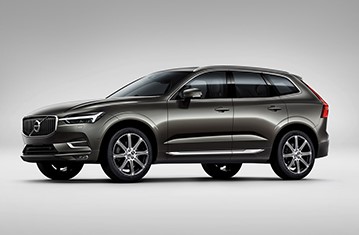
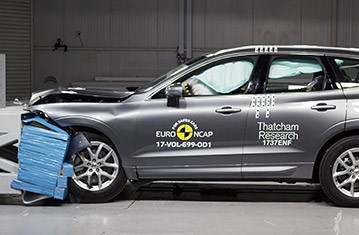

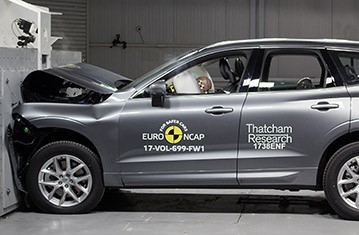
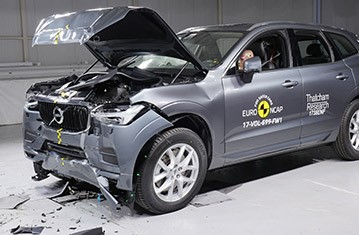
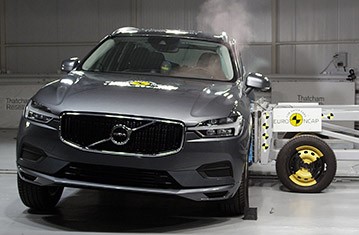
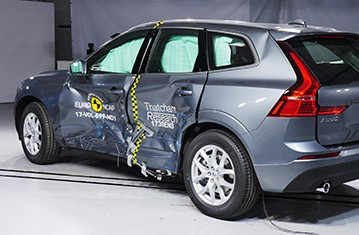
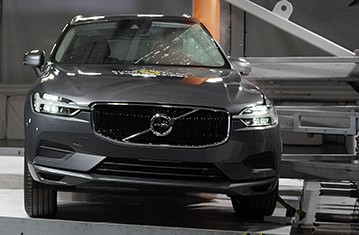
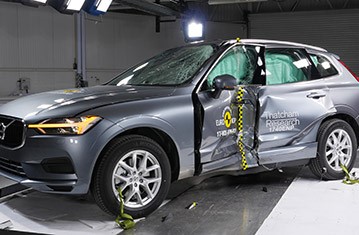



The passenger compartment of the XC60 remained stable in the frontal offset test. Dummy readings indicated good protection for all critical body areas of the passenger and of the knees and femurs of both the driver and passenger. Volvo showed that a similar level of protection would be provided to occupants of different sizes and to those sat in different positions. In the full-width rigid-barrier test, protection of both dummies was good except for the chest of the rear passenger, protection of which was rated as marginal. In both the side barrier test and the more severe side pole impact, protection of critical body areas was good and the XC60 scored maximum points. Tests on the front seats and head restraints demonstrated good protection against whiplash injuries in the event of a rear-end collision. A geometric assessment of the rear seats also indicated good whiplash protection. The standard-fit autonomous emergency braking system scored maximum points in tests of its functionality at the low-speeds typical of city driving, with collisions avoided at all test speeds.